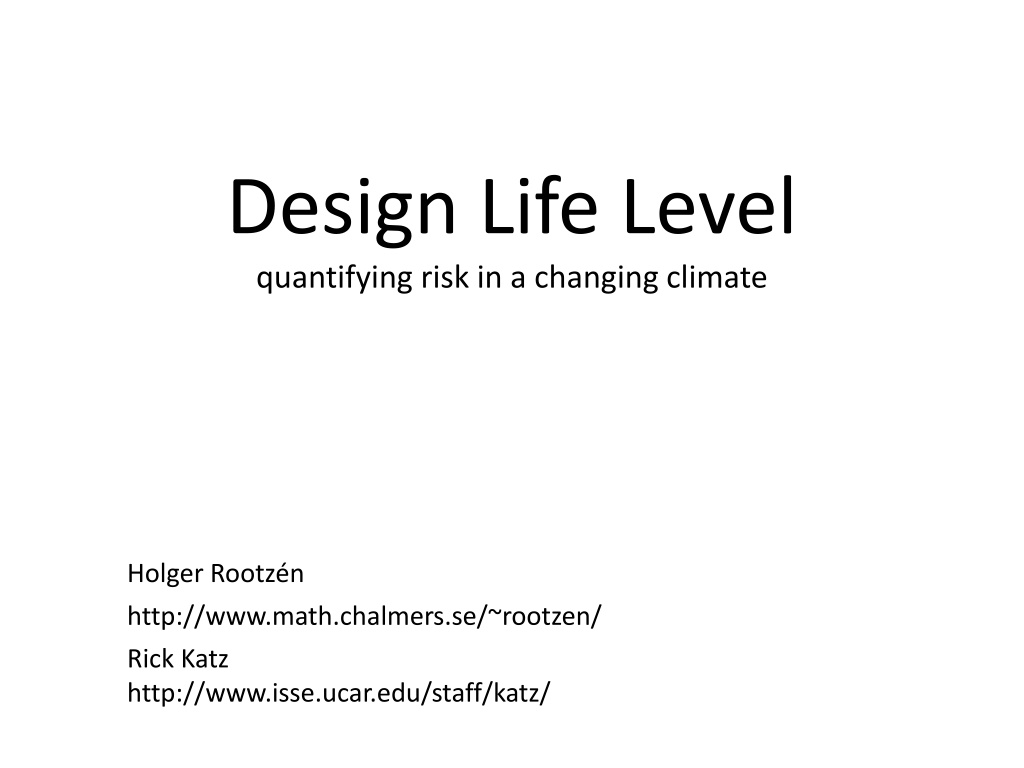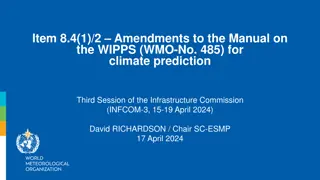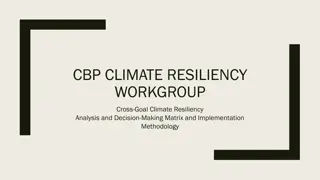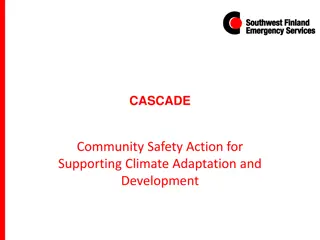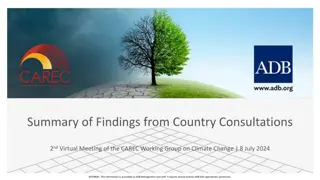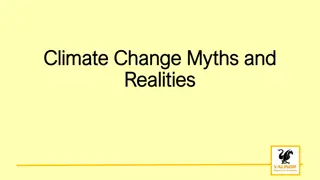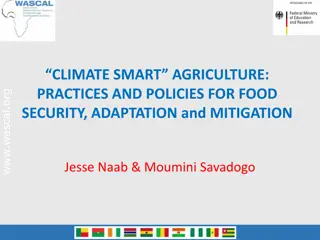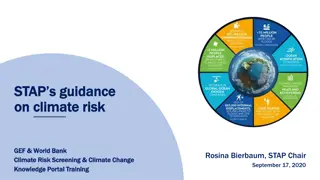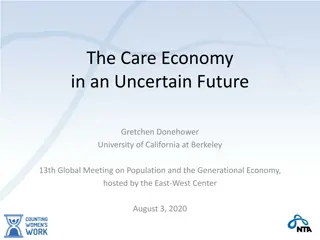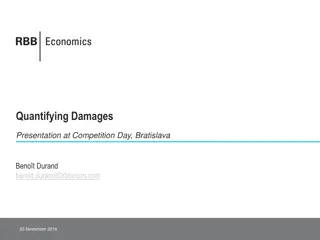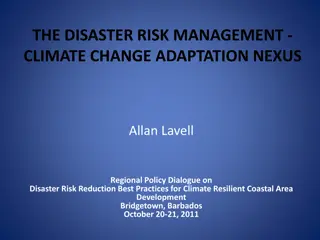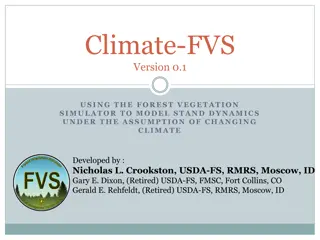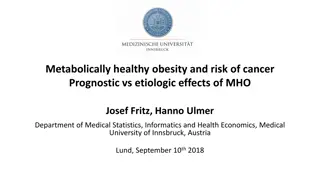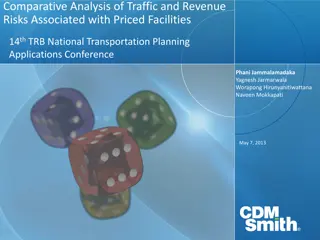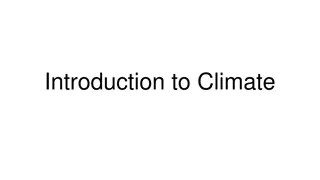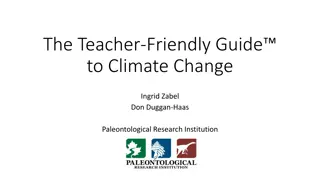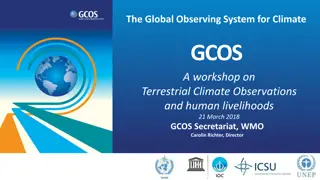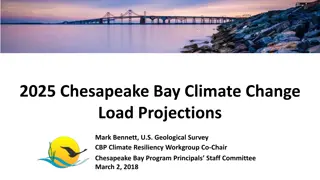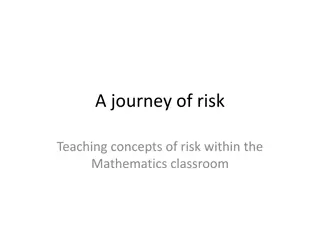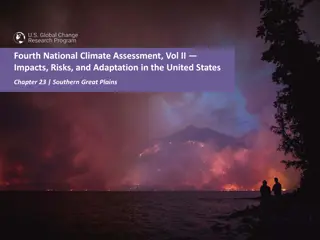Quantifying Risk in a Changing Climate with Design Life Level
Explore the intersection of design life level and quantifying risk in a changing climate, delving into concepts such as return levels, stationary practice, and the impact on engineering structures like dams and dikes. The discussion spans from the past to the future, emphasizing the complexities of non-stationarity and dependence in risk assessment.
Uploaded on Oct 02, 2024 | 0 Views
Download Presentation

Please find below an Image/Link to download the presentation.
The content on the website is provided AS IS for your information and personal use only. It may not be sold, licensed, or shared on other websites without obtaining consent from the author. Download presentation by click this link. If you encounter any issues during the download, it is possible that the publisher has removed the file from their server.
E N D
Presentation Transcript
Design Life Level quantifying risk in a changing climate Holger Rootz n http://www.math.chalmers.se/~rootzen/ Rick Katz http://www.isse.ucar.edu/staff/katz/
make dam 1.5 m higher costs billions of Euros, popular protests keep dam as is (perhaps) thousands of deaths
Current stationary practice: return levels 10,000-year flood: water level ? = ?10,000which on the average is exceeded once every ten thousand years = 1/10,000 quantile of the yearly maximum flood distribution In a stationary climate with independent years P(10,000yearmax > ?10,000) 1 ? 1 0.63 One number gives you many things at once. E.g. if you design dykes to resist the 10,000-year flood, then you know that the 100-year probability of a catastrophe is 1 ? 0.01 0.01 for any 100-year period. doesn t make sense in a changing climate
Current stationary practice: return periods Return Period ??: average time to exceedance of the level ? 1 ? time to exceedances of u = ??= 1 F(??) tempting to use return periods also in non-stationary climate -- but not a good idea
French dams and Dutch dikes: 10,000 year return levels 10,000 years ago, there were few humans and little civilization on earth. 10,000 year from now, our world will be completely and utterly different in ways we cannot even imagine now. Common codes: 100 year return levels From 1913 to 2012 we have passed from a largely non-industrialized world to a post-industrial world. There has been two world wars, the Soviet Union has appeared and vanished, and China is rising to become the major superpower. Also 100 years from now the world will be completely different. But hopefully some major engineering structures will survive 100 years and more. However interpretations like the following do make sense The probability that an individual dam will fail next year is 1/10,000. There are (perhaps?) 650 dams in France, so on the average 650 x 100/10.000 = 6.5 dams will fail during the next 100 years -- but non-stationarity and dependence makes reality much more complex than this.
New concepts and tools Basic information for engineering design in a changing climate (whether global or local): (i) design life period (e.g., the next 50 yrs., say 2018-2067) (ii) risk (e.g., 5% chance) of a hazardous event (typically, in the form of the hydrologic variable exceeding a high level) Design Life Level (DLL) Minimax Design Life Level (MDLL) complemented by Risk plots Constant risk plots
The Design Life Level is defined as an upper quantile (e.g. 5%) of the distribution of the maximum value of the hydrological variable (e.g. water level) over the design life period. The concept Design Life Level is general: it is not tied to any specific method, say statistical or GCM based way to calculate it, and it is equally useful for independent and dependent extremes
Hypothetical example: flooding of a dam The distribution of the highest water level at the dam during year ? is assumed to follow a generalized extreme value cdf 1/?? ??? = ? 1+??? ?? ? ?? ?? ?? for 1 + ?? > 0 with ??= 1 + 0.002?, ??= 1 + 0.0002?, ??= 0.1 0.2% increase in mean per year could e.g. be caused by an increase in mean water level 0.2% increase in scale per year could e.g. be caused by climate becoming more variable
Results for hypothetical example Design Life Prob. Design Life Level Return Level (2015 climate) 10.9 14.4 10.9 14.4 2015-2064 0.05 11.5 2015-2064 0.01 15.2 2065-2114 0.05 12.6 2065-2114 0.01 16.6 Return levels are for T = 975 and T = 4975, respectively. e.g. the 5% design life level for 2015-2064 is 11.5 Technical quantification/communication: the 2015-2064 5 % highest water level is 11.5 m Communication with the public: there is a 1 in 20 risk that the biggest flood during 2015- 2064 will be higher than 11.5 m
Results for hypothetical example, cnt. Design Life Prob. Design Life Level Return Level EWT EWT 2015 climate trend stopped 2015-2064 0.05 11.5 10.9 251 788 2015-2064 0.01 15.2 14.4 431 3839 2065-2114 0.05 12.6 10.9 262 1008 2065-2114 0.01 16.6 14.4 453 5002 EWT is expected waiting time until first exceedance of the design life level Expected waiting times make sense also in a non-stationary climate but they are dramatically changed if one changes assumptions about what happens after the design life period
Complementary concepts The p%MinimaxDesign Life Level is the level for which the maximal probability of exceedance in any one of the years in the design life period is at most p% Technical quantification/communication: the 2015-2064 0.1% bounded yearly risk highest water level is 12.0 m Communication with the public: the risk that there will be a bigger flood than 12.0 m is less than 1 in 1000 for each year in the time period 2015-2064
The Risk Plot fixes a level and shows how the risk of exceeding this level varies for the different years in the design life period The Constant Risk Plot fixes a probability and for each year in the design life period displays the level which is exceeded with this probability
100 80 60 40 the 2011 2060 5% largest daily winter rainfall in Manjimup is 121 mm 2000 1940 1960 1980 Yearly maximum daily rainfall 0.1 100 0.05 60 20 0 2060 2011 2035 2011 2035 2060 The 0.1% constant risk plot The 121 mm-s risk plot
0 -10 -20 the 2021 2060 10 % highest minimum winter temperature in Fort Collins is 24 degrees -30 1990 2010 1970 Yearly minimum temperature 1.5 20 1 10 0.5 0 0 2060 2100 2021 2060 2100 2021 The 0.1% constant risk plot The 24 degree risk plot
Uncertainties Statistical uncertainties: confidence/prediction intervals Model uncertainties: model comparison, e.g. via maximum likelihood Trend uncertainties: difficult, sensitivity studies GCM uncertainties: choice of spatial resolution; differential equation models; future changes in human activity; extremes not well caught by models In design phase plan for later modification to make the construction more resistant, if need should arise. Plan for regular adjustment of rules for managing the construction. Plan for regular updating of risk measures as experience and knowledge increases.
Rootzen, H. and R. W.Katz (2013). Design Life Level: Quantifying risk in a changing climate. Water Resourses Res., 49, Since then (examples): Lins, H.F., Cohn, T.A., (2011). Stationarity: wanted dead or alive? J. Am. Water Resourses Assoc. 47, 969 475-480. Yan,L., Xiong, L., Guo, S., Xu, C., Xia, J., and Du, T. (2017). Comparison of four nonstationary hydrologic design methods for changing environment. DLL ENE = Equivalent Number of Exceedances ER = Equivalent Reliability ADLL=Average Design Life Level EWRI Task Committee: Stochastic Methods for Analyzing Nonstationary Extreme Hydrologic Events
Conclusions To handle and communicate risks in a changing climate one should specify both a period of time and a probability of failure If one is not aiming at design but just wants to illustrate the extent of changes simpler concepts may sometimes suffice We recognize that the concept of Design Life Level is a shift from more common standard-based to less common risk- based engineering design. But such a shift may be desirable even under a stationary climate.
Kuestions more than answers Design risk estimation regulation emergency planning communication for Urban flood Each location separately? River networks? An entire country? Windstorm Small catastrophes large catastrophes What dimensions can be handled right now? In future? Climate change? Dam breach
